How to write a fantastic thesis introduction (+15 examples)
The thesis introduction, usually chapter 1, is one of the most important chapters of a thesis. It sets the scene. It previews key arguments and findings. And it helps the reader to understand the structure of the thesis. In short, a lot is riding on this first chapter. With the following tips, you can write a powerful thesis introduction.
Disclosure: This post may contain affiliate links, which means I may earn a small commission if you make a purchase using the links below at no additional cost to you . I only recommend products or services that I truly believe can benefit my audience. As always, my opinions are my own.

Elements of a fantastic thesis introduction
Open with a (personal) story, begin with a problem, define a clear research gap, describe the scientific relevance of the thesis, describe the societal relevance of the thesis, write down the thesis’ core claim in 1-2 sentences, support your argument with sufficient evidence, consider possible objections, address the empirical research context, give a taste of the thesis’ empirical analysis, hint at the practical implications of the research, provide a reading guide, briefly summarise all chapters to come, design a figure illustrating the thesis structure.
An introductory chapter plays an integral part in every thesis. The first chapter has to include quite a lot of information to contextualise the research. At the same time, a good thesis introduction is not too long, but clear and to the point.
A powerful thesis introduction does the following:
- It captures the reader’s attention.
- It presents a clear research gap and emphasises the thesis’ relevance.
- It provides a compelling argument.
- It previews the research findings.
- It explains the structure of the thesis.
In addition, a powerful thesis introduction is well-written, logically structured, and free of grammar and spelling errors. Reputable thesis editors can elevate the quality of your introduction to the next level. If you are in search of a trustworthy thesis or dissertation editor who upholds high-quality standards and offers efficient turnaround times, I recommend the professional thesis and dissertation editing service provided by Editage .
This list can feel quite overwhelming. However, with some easy tips and tricks, you can accomplish all these goals in your thesis introduction. (And if you struggle with finding the right wording, have a look at academic key phrases for introductions .)
Ways to capture the reader’s attention
A powerful thesis introduction should spark the reader’s interest on the first pages. A reader should be enticed to continue reading! There are three common ways to capture the reader’s attention.
An established way to capture the reader’s attention in a thesis introduction is by starting with a story. Regardless of how abstract and ‘scientific’ the actual thesis content is, it can be useful to ease the reader into the topic with a short story.
This story can be, for instance, based on one of your study participants. It can also be a very personal account of one of your own experiences, which drew you to study the thesis topic in the first place.
Start by providing data or statistics
Data and statistics are another established way to immediately draw in your reader. Especially surprising or shocking numbers can highlight the importance of a thesis topic in the first few sentences!
So if your thesis topic lends itself to being kick-started with data or statistics, you are in for a quick and easy way to write a memorable thesis introduction.
The third established way to capture the reader’s attention is by starting with the problem that underlies your thesis. It is advisable to keep the problem simple. A few sentences at the start of the chapter should suffice.
Usually, at a later stage in the introductory chapter, it is common to go more in-depth, describing the research problem (and its scientific and societal relevance) in more detail.
You may also like: Minimalist writing for a better thesis
Emphasising the thesis’ relevance
A good thesis is a relevant thesis. No one wants to read about a concept that has already been explored hundreds of times, or that no one cares about.
Of course, a thesis heavily relies on the work of other scholars. However, each thesis is – and should be – unique. If you want to write a fantastic thesis introduction, your job is to point out this uniqueness!
In academic research, a research gap signifies a research area or research question that has not been explored yet, that has been insufficiently explored, or whose insights and findings are outdated.
Every thesis needs a crystal-clear research gap. Spell it out instead of letting your reader figure out why your thesis is relevant.
* This example has been taken from an actual academic paper on toxic behaviour in online games: Liu, J. and Agur, C. (2022). “After All, They Don’t Know Me” Exploring the Psychological Mechanisms of Toxic Behavior in Online Games. Games and Culture 1–24, DOI: 10.1177/15554120221115397
The scientific relevance of a thesis highlights the importance of your work in terms of advancing theoretical insights on a topic. You can think of this part as your contribution to the (international) academic literature.
Scientific relevance comes in different forms. For instance, you can critically assess a prominent theory explaining a specific phenomenon. Maybe something is missing? Or you can develop a novel framework that combines different frameworks used by other scholars. Or you can draw attention to the context-specific nature of a phenomenon that is discussed in the international literature.
The societal relevance of a thesis highlights the importance of your research in more practical terms. You can think of this part as your contribution beyond theoretical insights and academic publications.
Why are your insights useful? Who can benefit from your insights? How can your insights improve existing practices?

Formulating a compelling argument
Arguments are sets of reasons supporting an idea, which – in academia – often integrate theoretical and empirical insights. Think of an argument as an umbrella statement, or core claim. It should be no longer than one or two sentences.
Including an argument in the introduction of your thesis may seem counterintuitive. After all, the reader will be introduced to your core claim before reading all the chapters of your thesis that led you to this claim in the first place.
But rest assured: A clear argument at the start of your thesis introduction is a sign of a good thesis. It works like a movie teaser to generate interest. And it helps the reader to follow your subsequent line of argumentation.
The core claim of your thesis should be accompanied by sufficient evidence. This does not mean that you have to write 10 pages about your results at this point.
However, you do need to show the reader that your claim is credible and legitimate because of the work you have done.
A good argument already anticipates possible objections. Not everyone will agree with your core claim. Therefore, it is smart to think ahead. What criticism can you expect?
Think about reasons or opposing positions that people can come up with to disagree with your claim. Then, try to address them head-on.
Providing a captivating preview of findings
Similar to presenting a compelling argument, a fantastic thesis introduction also previews some of the findings. When reading an introduction, the reader wants to learn a bit more about the research context. Furthermore, a reader should get a taste of the type of analysis that will be conducted. And lastly, a hint at the practical implications of the findings encourages the reader to read until the end.
If you focus on a specific empirical context, make sure to provide some information about it. The empirical context could be, for instance, a country, an island, a school or city. Make sure the reader understands why you chose this context for your research, and why it fits to your research objective.
If you did all your research in a lab, this section is obviously irrelevant. However, in that case you should explain the setup of your experiment, etcetera.
The empirical part of your thesis centers around the collection and analysis of information. What information, and what evidence, did you generate? And what are some of the key findings?
For instance, you can provide a short summary of the different research methods that you used to collect data. Followed by a short overview of how you analysed this data, and some of the key findings. The reader needs to understand why your empirical analysis is worth reading.
You already highlighted the practical relevance of your thesis in the introductory chapter. However, you should also provide a preview of some of the practical implications that you will develop in your thesis based on your findings.
Presenting a crystal clear thesis structure
A fantastic thesis introduction helps the reader to understand the structure and logic of your whole thesis. This is probably the easiest part to write in a thesis introduction. However, this part can be best written at the very end, once everything else is ready.
A reading guide is an essential part in a thesis introduction! Usually, the reading guide can be found toward the end of the introductory chapter.
The reading guide basically tells the reader what to expect in the chapters to come.
In a longer thesis, such as a PhD thesis, it can be smart to provide a summary of each chapter to come. Think of a paragraph for each chapter, almost in the form of an abstract.
For shorter theses, which also have a shorter introduction, this step is not necessary.
Especially for longer theses, it tends to be a good idea to design a simple figure that illustrates the structure of your thesis. It helps the reader to better grasp the logic of your thesis.
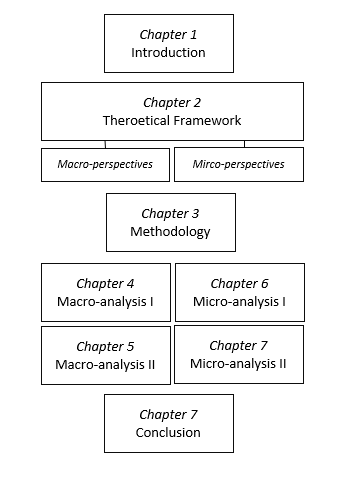
Master Academia
Get new content delivered directly to your inbox.
Subscribe and receive Master Academia's quarterly newsletter.
The most useful academic social networking sites for PhD students
10 reasons not to do a master's degree, related articles.

Minimalist writing for a better thesis

How to write a literature review introduction (+ examples)

Why you cannot write a PhD thesis in 3-6 months

First meeting with your dissertation supervisor: What to expect
Reference management. Clean and simple.
How to write a good thesis introduction

1. Identify your readership
2. hook the reader and grab their attention, 3. provide relevant background, 4. give the reader a sense of what the paper is about, 5. preview key points and lead into your thesis statement, frequently asked questions about writing a good thesis introduction, related articles.
Many people struggle to write a thesis introduction. Much of your research prep should be done and you should be ready to start your introduction. But often, it’s not clear what needs to be included in a thesis introduction. If you feel stuck at this point not knowing how to start, this guide can help.
Tip: If you’re really struggling to write your thesis intro, consider putting in a placeholder until you write more of the body of your thesis. Then, come back to your intro once you have a stronger sense of the overall content of your thesis.
A good introduction draws readers in while providing the setup for the entire project. There is no single way to write an introduction that will always work for every topic , but the points below can act as a guide. These points can help you write a good thesis introduction.
Before even starting with your first sentence, consider who your readers are. Most likely, your readers will be the professors who are advising you on your thesis.
You should also consider readers of your thesis who are not specialists in your field. Writing with them in your mind will help you to be as clear as possible; this will make your thesis more understandable and enjoyable overall.
Tip: Always strive to be clear, correct, concrete, and concise in your writing.
The first sentence of the thesis is crucial. Looking back at your own research, think about how other writers may have hooked you.
It is common to start with a question or quotation, but these types of hooks are often overused. The best way to start your introduction is with a sentence that is broad and interesting and that seamlessly transitions into your argument.
Once again, consider your audience and how much background information they need to understand your approach. You can start by making a list of what is interesting about your topic:
- Are there any current events or controversies associated with your topic that might be interesting for your introduction?
- What kinds of background information might be useful for a reader to understand right away?
- Are there historical anecdotes or other situations that uniquely illustrate an important aspect of your argument?
A good introduction also needs to contain enough background information to allow the reader to understand the thesis statement and arguments. The amount of background information required will depend on the topic .
There should be enough background information so you don't have to spend too much time with it in the body of the thesis, but not so much that it becomes uninteresting.
Tip: Strike a balance between background information that is too broad or too specific.
Let the reader know what the purpose of the study is. Make sure to include the following points:
- Briefly describe the motivation behind your research.
- Describe the topic and scope of your research.
- Explain the practical relevance of your research.
- Explain the scholarly consensus related to your topic: briefly explain the most important articles and how they are related to your research.
At the end of your introduction, you should lead into your thesis statement by briefly bringing up a few of your main supporting details and by previewing what will be covered in the main part of the thesis. You’ll want to highlight the overall structure of your thesis so that readers will have a sense of what they will encounter as they read.
A good introduction draws readers in while providing the setup for the entire project. There is no single way to write an introduction that will always work for every topic, but these tips will help you write a great introduction:
- Identify your readership.
- Grab the reader's attention.
- Provide relevant background.
- Preview key points and lead into the thesis statement.
A good introduction needs to contain enough background information, and let the reader know what the purpose of the study is. Make sure to include the following points:
- Briefly describe the motivation for your research.
The length of the introduction will depend on the length of the whole thesis. Usually, an introduction makes up roughly 10 per cent of the total word count.
The best way to start your introduction is with a sentence that is broad and interesting and that seamlessly transitions into your argument. Consider the audience, then think of something that would grab their attention.
In Open Access: Theses and Dissertations you can find thousands of recent works. Take a look at any of the theses or dissertations for real-life examples of introductions that were already approved.


Thesis Introduction
Ai generator.
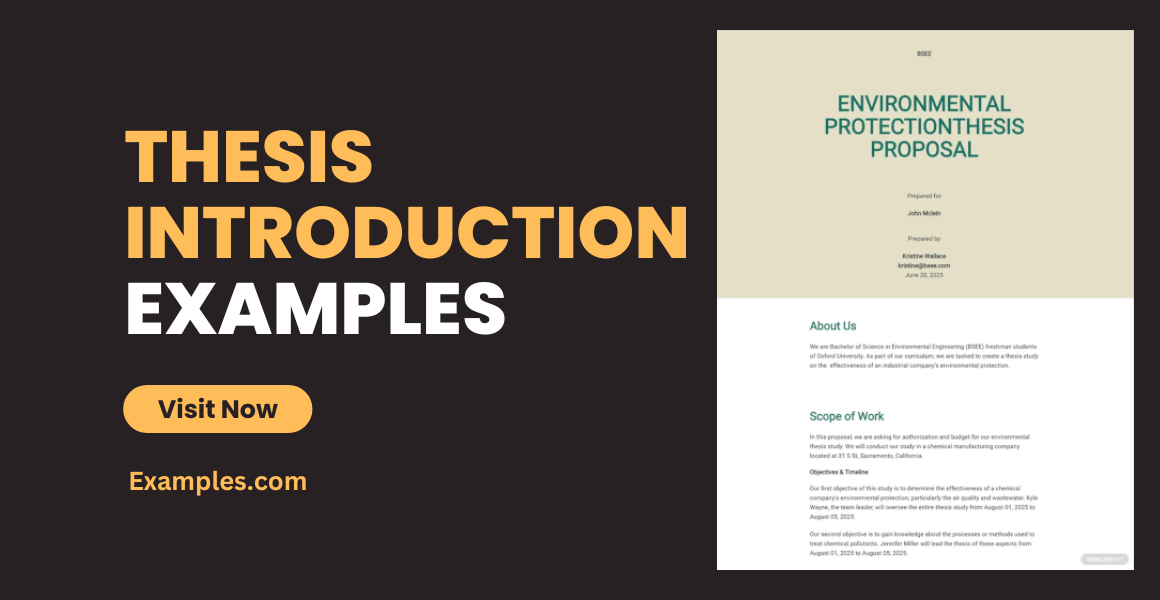
After coming up with your desired topic for your thesis, it is about time that you began preparing that introduction. Just like every good speech or story, you need to have an introduction as to what your thesis outline is all about and what aspects your research will be covering.
In the introduction part of your thesis, you should be trying to focus on three main things, which are called Moves, according to the University of New South Wales database:

Move 1. E stablish your territory
By marking your territory, you begin to elaborate on what your topic is about and its present situation at hand. In doing so, there is also a need for you to point out that your area of research will only be limited to this scope, and for it to go beyond your area of responsibility would be out of the context. You may also see essay examples .
Move 2. E stablish a niche
This section is the heart and soul of your introduction. Without this, why was there even the need to conduct your research in the first place if you do not know what for?
Move 3. Introduce the current research
In conclusion to your introduction, this is where your research steps into the spotlight. In this part, you will be giving the panel a glimpse of the questions the researchers would be tackling during the course of the thesis journey. Aside from stating the hypotheses in this section, it is also important for the researchers to identify early on the end goals the study wants to achieve. You may also see thesis statement .
Each Move has a number of stages. Depending on what you need to say in your introduction, you might use one or more stages. You will also find examples of introductions, divided into stages with sample sentence extracts.
Most thesis introductions include some (but not all) of the stages listed below. There are variations between different schools and between different thesis, depending on the purpose of the thesis. You may also see essay writings .
Stages in a thesis introduction
- State the general topic and give some background.
- Provide a review of the literature related to the topic.
- Define the terms and scope of the topic.
- Outline the current situation.
- Evaluate the current situation (advantages/ disadvantages) and identify the gap.
- Identify the importance of the proposed research.
- State the research problem/questions.
- State the research aims and/or research objectives
- State the hypotheses.
- Outline the order of information in the thesis.
- Outline the methodology.
Listed below is a sample thesis introduction that was made by me and my partner during our college days. You may notice in the introduction, proponents of previous researchers who have conducted a similar study before since the opinion of experts gives the study basis and grounds as to why this topic requires more future studies. You may also see thesis proposal .
Introduction
Even as traditional media continues to be overshadowed by the insurmountable rise of electronic technology such as internet and mobile phones to access online information, daily newspapers have remained to be a key platform in disseminating public information which incites public discourse. A banner story of a newspaper is considered the highlight and most important news story of the day as newspapers follow an order of stories by arranging them of importance from front to inside pages (Tewksbury, 2002). You may also see personal essay .
At present, however, the media is confronted with issues such as making sensationalized, misleading, and satirical news stories not primarily to provide what the readers need to know, but rather to increase the issue’s marketability and compensate for the company’s production cost. Its gigantic headline running from corner to corner accompanied by its banner picture along with the story itself are put in place to draw readers’ attention and set the tone of the issue (Saxena, 2013). These existing practices greatly affect the placement of news stories from the most relevant and significant ones to the least leaving behind many substantial stories given less attention or least, under-reported. Moreover, this dilemma defeats the purpose of the main objectiveof journalism which is to provide the citizenry with information that is vital in shaping their realities and guide them in their decision making which then collates to a more systematic society. You may also see persuasive essay .
For instance, a local English daily placed the slain Bohol town mayor’s story, which reached national coverage, as its banner story of the issue while placing the progress of Cebu City’s Bus Rail Transit (BRT) project, which offers an opportunity for citizens to escape from the almost unmanageable metropolitan traffic jam when pushed through, in the latter pages of the issue. More so, with the long-aged flood problem in the metropolis especially during rainy season, a local English daily published on its second page an article entitled “Garganera: No program to solve flooding” due to the lack of comprehensive programs. You may also see short essay .
However, this did not land in the banner story, despite the relevance and the problem it seeks to raise; instead, a story about a landslide that killed two people was the highlight of the day. Hence, as it can be observed, politics, crime or disaster-based news which would likely create a stir among readers are most often than not picked as the banner story of the day. There are other news stories in other news categories that if written with the right angle and is deemed timely, can have its chance at the banner story. The news is a by-product of a journalist’s job of gathering enough evidence, conducting interviews and constant research in pursuit of the truth. In a newsroom, it is the editorial board that decides what news should be placed as the banner story which they perceive to be the most relevant news for the public to know. You may also see essay examples .
But sometimes, what the newspapers present as their banner story may not really align with the readers’ interests or perhaps may not strike as the most important or critical issue of the day. According to MacGregor (2007), journalists have been known to stray from their audiences in the context of traditional media. Gieber asserts (1960: 2004) that “news selection has no direct relationship to the wants of readers.” Gans (1979) further emphasizes Gieber’s point saying that journalists pay little to no attention to audience feedback, but place certain news together based on what they think would interest their audiences. You may also see reflective essay .
However, most, if not all of the reading public has no clue on how the editorial board decides each story’s position and inclusion. A proof of the abovementioned issues encompassing the news media industry is the presence of internal watchdogs that specialize on in-depth journalism to cover that under-reported news that is often overlooked by the mainstream news media. The Reuters Foundation is among those that provide the public with stories unlikely read or seen in the mainstream news such as humanitarian, women’s rights, human trafficking-based news. You may also see student essay .
One way or another, the media, in whatever form that it takes will never be perfect and will always be accused of bias and sensationalism which leads to public distrust. According to the analysis of some scholars, (Blumler and Gurevitch, 1995; McManus, 1994; Grabe et al., 2001) they have observed that the news is becoming more sensational or ‘tabloid-like’ over time. These kinds of stories may render the news more ‘colorful’ but are not exactly more informative (Blumler and Gurevitch, 1995; Franklin, 2005). You may also see analytical essay
Which is why one other end goal that the study wants to achieve is for each newspaper editorial board to be transparent on how the body decides each story should be written as well as the selection process of the news stories that determine which page each story belongs to. At the same time, it is also crucial that the public themselves understand how the editorial process is being done to grasp the concept behind story selection and editorial judgment in hopes that the strong trust between the public and the media will be restored once more as the media continues to deliver the news to the reading public with the challenge that they remain loyal and trustworthy by them.You may also see concept essay .
Only front-page studies are available for the researchers’ basis for their research as there were very minimal studies on banner stories. This study will be conducted for the purpose of understanding the present landscape of Cebu’s three local English newspapers. As compared to other media researchers, this will focus on identifying the most frequent news category published in the banner story of Cebu’s three local English newspapers: Cebu Daily News, SunStar Cebu, and The Freeman. Additionally, the researchers would also analyze the rhetoric of the dailies based on 1) the news values assigned by the journalists in every news story, and 2) the standard basis utilized by each newspaper’s editorial board in the selection process of news stories.You may also see comparative essay .
If you think the Introduction part of the thesis is exhausting, just wait until you get to the theoretical background and the review of related literature. They say those parts just crushes the soul out of you during the first half of your thesis writing. But do not fret. Because even though writing a thesis is like taking a walk in the park (Jurassic Park), all that hassle is really worth the tassel. Good luck!
Thesis Table Of Contents Template
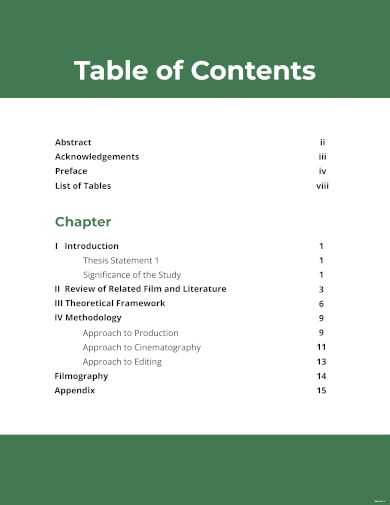
- Google Docs
- Apple Pages
- MS Publisher
Size: 36 KB
Thesis Proposal Template
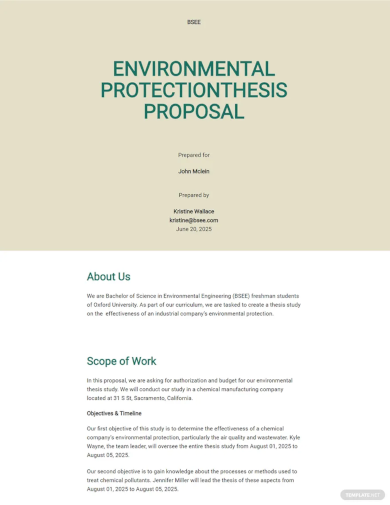
Size: 80 KB
Thesis Proposal Gantt Chart Template
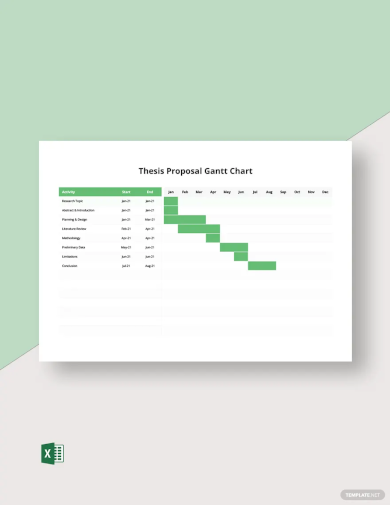
Size: 30 KB
Text prompt
- Instructive
- Professional
10 Examples of Public speaking
20 Examples of Gas lighting
- AI Detector and Humanizer
- Business Solutions
- Try it Free
How to Write a Thesis Introduction (with Examples)

As Ralph Waldo Emerson once said, “Sometimes a scream is better than a thesis.” While it’s ironically the case for many, writing a thesis is basically the culmination of your hard work.
There’s a certain pride in accomplishing such a task, and many people hold it close to their hearts throughout their lifetimes.
This showcases a student’s ability to contribute original insights to their field and opens many more doors to broaden their academic and professional opportunities. Finishing a thesis certainly has weight.
The great thing about education today is that technology can help make things easier. AI tools, for instance, can assist with writing research papers and doing thesis work.
Even teachers can utilize the power of AI to improve their ways of teaching – but more on the exciting AI stuff later.
What you need to start with for your thesis is to create a strong introduction. Your thesis intro sets the tone for your entire work, so getting it right is important.
Here’s everything you need to know on how to write a thesis introduction that instantly catches the eye and informs effectively at a glance.
What Types of Information Should Be Included in Your Thesis Introduction?
After days and nights of researching, typing, and editing, the general average thesis length ends up at around 20-50 pages.

A PhD dissertation, usually tougher, can go up to 90-500 pages long. That’s a lot of work.
With so much information to showcase, your thesis intro should be able to make a big impression. A weak introduction can mislead your readers and even diminish the value of your entire thesis.

Never Worry About AI Detecting Your Texts Again. Undetectable AI Can Help You:
- Make your AI assisted writing appear human-like.
- Bypass all major AI detection tools with just one click.
- Use AI safely and confidently in school and work.
As the first impression of your work, the intro sets the stage by providing some context, highlighting the research problem, and laying out your objectives clearly.
It can be intimidating just thinking about it, so we’re here to make sure your thesis intro delivers the punch it needs. Here are some things that you should include.
Have an attention-grabbing opening
In the marketing world, you’ve only got eight seconds to grab a customer’s attention; that’s the average attention span.
While your teacher won’t drop your thesis if your introduction doesn’t grab them within seconds, having a great opening can still make a strong impact.
The main goal here is to present a compelling hook that sparks curiosity.
Include a surprising statistic, engage with a thought-provoking question, share a short but relatable anecdote, or try to be daring and make a bold statement that shocks but relates to your research topic.
There are many ways to do it, but ultimately, you want to engage your reader right from the start.
Provide context and the importance of the topic
“In this thesis, we will be exploring the effects of social media on communication.” Why, though? And what part of social media are we talking about here?
This is a bad example of a thesis intro because it lacks context.
Instead of simply choosing a controversial or topical subject to make an impact, you need to go deeper straight away.
The goal of providing context is to guide your reader in understanding why your topic is worth discussing in the first place.
You can offer a brief overview of already existing research and how you can add to it, and also show the gaps and unresolved issues that your study aims to fix.
Highlighting your topic goes to show that it’s an important matter to discuss in your field.
Engage through specific questions that your research addresses
One of the best ways to make your thesis intro stand out is by asking specific questions.
For example, if your research is about the effects of social media on traditional media, rather than just stating it outright, you can start off with an engaging question like “Is social media ending the age of the newspaper?”
In this way, you instantly grab the attention of your reader with a compelling question while still providing a sense of what your research will be about.
It’s a two-punch combo of showing immediate purpose and relevance while making your thesis intro easy to follow.
Frame your research in the form of specific and engaging questions so you can lay the groundwork for a more focused thesis.
Thesis Introduction Tips

So far, a good thesis introduction should be able to outline the main topic clearly, present some compelling questions, and provide context and significance for the study.
It’s definitely not easy, but there are ways to make it more doable. Here are some handy thesis introduction tips to help you out.
Know your audience
Knowing your audience means that you understand who will be reading your thesis. By doing this, you can create an introduction that meets their expectations and interests.
When writing a thesis intro, you should be able to consider the background, knowledge level, and interests of the thesis readers – your advisor, committee members, and other related academics.
Knowing this, you can set the right tone, which is usually formal, and engage in a way that interests them.
Refer to your thesis proposal or notes
If you want to make a seamless thesis paper, you will constantly need to refer to your proposal and notes.
You should refer to all the preliminary work that you’ve done to direct the writing of your introduction.
This can include your research questions, objectives, literature review, and methodology that you’ve outlined for your proposal.
It’s always important to go back and review your thesis notes regularly because these help you:
- Ensure that your thesis introduction is consistent with your original proposal.
- Present the main elements of your research.
- Organize your thoughts and create a well-structured introduction, contributing to your overall thesis flow.
Keep your thesis proposal and notes by your side. They will help you create a strong introduction that provides clear context for your research.
Use Assistant AI tools to help with writing and proofreading
Especially when it comes to writing, AI tools have become quite useful.
You might already be familiar with ChatGPT, which uses advanced algorithms to generate the needed content; it can even proofread text .
AI tools can be useful to writers and researchers by offering suggestions and writing parts of the work that they can improve later.
This makes the writing process a whole lot more efficient and much less time-consuming. With AI, you can essentially produce high-quality work under tight deadlines.
However, while AI tools are clearly helpful, it’s necessary that you still use them responsibly.
AI plagiarism is a growing concern that happens when any AI-generated content is presented as original work without giving the right acknowledgment.
This can severely damage the credibility of your research and even get you in trouble.
Treat AI as what it’s intended to be – a tool – rather than the main writer of your work. You should still be the writer of your own work.
To avoid any issue with AI, a reliable detector like Undetectable AI can be used to always make sure that your content passes as human-written.
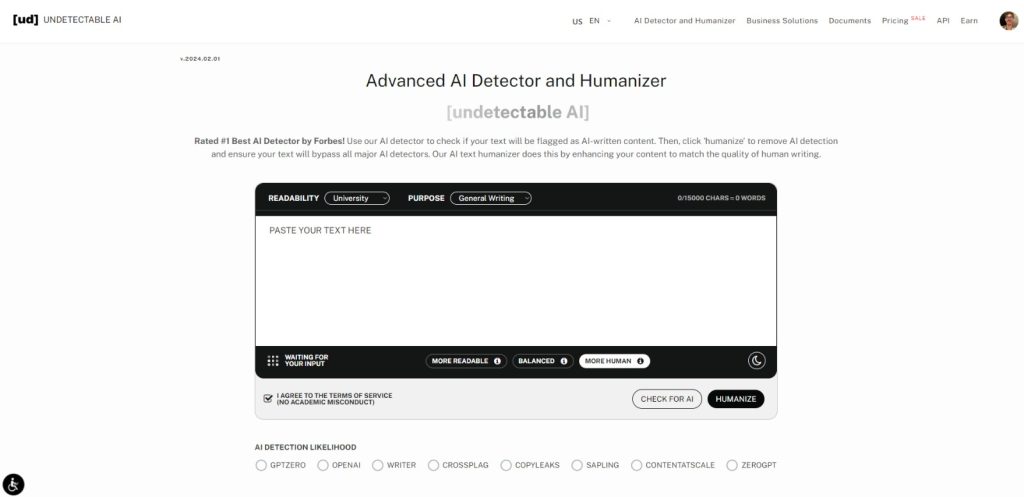
Undetectable analyzes any text you submit to effectively detect AI content. It also includes features like a humanizer that adjusts the writing to match a natural human tone .
We certainly don’t want to stop you from maximizing your potential with the help of AI, so with a useful AI detector and humanizer by your side, you can always get the results you want.
You can try Undetectable AI easily with the widget below (English only). Just input your text and see how it can transform your writing!
Make sure you clearly state your topic, aims, and objectives
This one is essential. Your thesis introduction should be able to clearly define what your research is about (topic), what you plan to accomplish (aims), and the steps you’re taking to get there (objectives).
It’s pretty straightforward and is a no-brainer, but you must do this for several reasons:
- Helps your readers understand the focus of your research right from the get-go.
- Sets clear expectations for your thesis.
- Establishes relevance, making your work highly credible.
- Easier assessment (whether you’ve achieved your goals) by your advisor and evaluators.
Remember, a well-defined introduction is your first step toward a successful thesis. Make it matter.
Explain why your research matters
If your thesis doesn’t make an impact in your field, then it might not be seen as valuable. So, from the start, be sure to explain why your research matters.
This provides a basis for why you’re choosing a specific topic in the first place and explaining why it deserves their attention.
To help, you can also link your research to real-world applications or social issues to enhance its appeal to the research community and beyond.
3 Thesis Introduction Examples to Inspire You

Writing a thesis introduction can be quite a challenge, but looking at examples can help you understand how to start your research on the right foot.
Communications Example
“Is social media ending the age of the newspaper?” This question frequently arises in discussions as the communication landscape continuously evolves.
Platforms like Facebook, X (previously called Twitter), and Instagram continue to grow, and their impact on traditional media – newspapers, television, and radio – becomes more significant and complex.
Social media has drastically changed how people access information. Unlike traditional media, which professional journalists and editors usually produce, social media allows anyone to create and share content.
This shift has huge implications for both media producers and consumers. Understanding these changes is important for professionals in the field and the general population.
This thesis aims to answer several questions: How has social media affected the credibility of traditional news sources?
What strategies are traditional media adopting to compete in a digital world? And how do today’s audiences perceive news found on social media vs traditional platforms?
By addressing these questions, this research seeks to provide a comprehensive understanding of the current media landscape and provide some discourse on the future of communication and modern-day responsible journalism.

Environmental Science Example
Food production is one of the largest contributors to environmental damage.
The methods that we traditionally use to grow and raise our food have serious implications for resource use, greenhouse gas emissions, and land use.
So, we ask the question, “Can our food choices save the planet?”
As global populations rise and climate change accelerates, understanding the environmental impact of different food production systems has never been more important.
Plant-based agriculture and animal-based agriculture differ considerably, so studying these differences can help identify sustainable practices that minimize and ultimately prevent environmental damage.
This thesis aims to address how plant-based and animal-based food production systems compare in terms of resource use and environmental impact and what practices within these systems can reduce their impact on the environment.
Education Example
The global pandemic has made a dent in how we live, and that includes the state of education.
During this difficult time, schools and universities worldwide were essentially forced to shift to online learning almost overnight.
This sudden and widespread adoption of online learning presents a unique opportunity to assess its effectiveness and impact on education – past the pandemic.
If online learning is actually shown to be effective, it could lead to more flexible, accessible, and inclusive educational practices.
Conversely, if notable shortcomings are identified, this can highlight areas that need improvement to support students and educators better.
This thesis aims to identify the effectiveness of online learning in achieving educational outcomes compared to traditional classroom settings, the major challenges faced by students and educators during this transition, and how factors such as socioeconomic status and access to technology influence the effectiveness of online learning.
With this study, we can provide valuable insights into the strengths and weaknesses of online education, contributing to the broader discussion of post-pandemic learning.
How do you start an introduction for a thesis?
To start a thesis introduction, start with a hook that draws the reader in and sets the stage for your research topic. Provide context by discussing the significance of the topic. Then transition into your thesis statement, which outlines the main argument or purpose of your research.
What is an example of a thesis statement in an introduction?
An example of a thesis statement in an introduction could be: “This thesis examines how social media platforms like Facebook, Instagram, and X (formerly Twitter) have reshaped how individuals interact and form relationships in the digital age, with an emphasis on interpersonal communication.” Clearly state the main focus and purpose of your research and provide a roadmap for the reader to understand what will be discussed in your thesis.
What is a good way to start a thesis statement?
You could start a thesis statement by introducing your topic and talking about the specific angle you plan to explore in your research. Grab the reader’s attention and establish why it’s worth investigating further.
How do you start writing a thesis?
Writing a thesis starts with choosing a topic that interests you – and then aligns with your field. Be sure that the main goal of your thesis stays relevant to gain some credibility. With this, you can create a clear thesis statement that outlines the main objective of your study. This is where you can start drafting a compelling thesis introduction and then filling your content with strong arguments that are supported by evidence and analysis. Firmly conclude with a summary of your findings and their implications. Always cite your sources accurately and follow the academic guidelines.
Maximizing the potential of your thesis always starts with an introduction, and with the help of AI tools, you can be confident to write a strong one.
When using these tools, just be sure to have Undetectable AI by your side so that any content you need assistance with stays authentic.
The humanizer feature matches real human writing styles as closely as possible so that your content speaks to your readers.
Remember to tailor your thesis introduction to your specific research topic and audience, and use examples and evidence to back up your claims.
With these strategies in mind, you’ll be well-equipped to write an impactful thesis introduction – paving the way for a great thesis.
- College Essay
- Argumentative Essay
- Expository Essay
- Narrative Essay
- Descriptive Essay
- Scholarship Essay
- Admission Essay
- Reflective Essay
- Nursing Essay
- Economics Essay
Assignments
- Term Papers
- Research Papers
- Case Studies
- Dissertation
- Presentation
- Editing Help
- Cheap Essay Writing
- How to Order
Thesis Writing
Writing A Thesis Introduction
Thesis Introduction: A Step-by-Step Guide With Examples
11 min read

People also read
Thesis Writing - An Ultimate Writing Guide With Tips & Examples
How to Write a Thesis Proposal - Sample Proposals and Tips!
Interesting Thesis Topics & Ideas To Get Started
Thesis Format Essentials: Structure, Tips, and Templates
You're staring at a blinking cursor, trying to figure out where to start your introduction for your thesis writing.
It's hard to know where to start, and even harder to keep your introduction engaging and on-topic.
We've written this guide that will take you step-by-step through the process of writing an amazing introduction. You'll also find examples of introductions for different types of papers.
So let's get started!
- 1. What is a Thesis Introduction?
- 2. Components of Thesis Introduction
- 3. Thesis Introduction Outline
- 4. How to Start a Thesis Introduction?
- 5. How to Write a Thesis Introduction?
- 6. Thesis Introduction Examples
- 7. Thesis Introduction Writing Tips
- 8. Introduction Writing Checklist
What is a Thesis Introduction?
A thesis introduction is the opening section of a research paper or thesis writing that serves as a roadmap for the entire study.
It provides context and background information for the research topic. The introduction outlines the study's purpose, problem statement, and methodology.
It engages readers, captures their interest, and sets expectations for the rest of the paper.
Importance of Writing a Good Thesis Introduction
Let’s see why a good introduction is important in thesis writing:
- First Impressions: The introduction is your first opportunity to make a positive impression on readers. It's crucial in piquing their interest.
- Contextual Understanding: It offers the necessary background information, ensuring that readers comprehend the research's significance and relevance.
- Problem Statement: The introduction presents the research problem, outlining what the study aims to address, and emphasizing its importance.
- Clarity: A well-structured introduction enhances the clarity of your work, making it easier for readers to follow your thesis.
- Guidance: It serves as a guide for the reader, providing a clear path of what to expect throughout the research, including the methodology and expected outcomes.
How Long is a Thesis Introduction?
The introduction of your thesis paper makes up roughly 10% of your total word count. Therefore, a PhD thesis paper introduction would be 8000 - 10000 words. However, a Master's thesis would be 1500 - 2000 words long.
Although the thesis introduction length can be increased if the writer includes images, diagrams, and descriptions.
Components of Thesis Introduction
The thesis introduction format comprises several essential components that collectively set the stage for your research. These components include:
- Hook or Attention-Grabber
- Background Information
- Problem Statement
- Purpose of the Study
- Significance of the Research
- Overview of the Methodology
Thesis Introduction Outline
A thesis introduction chapter structure contains the following sections:
Thesis Introduction Outline Sample

Paper Due? Why Suffer? That's our Job!
How to Start a Thesis Introduction?
Starting a thesis introduction can be overwhelming, but there are some steps you can follow to make it easier:
- Choose a Topic Select a topic that you are passionate about and that aligns with your research interests. Your topic should also be relevant to your field of study and have enough existing research to support your thesis. You can also choose unique ideas from our compiled list of thesis topics .
- Research the Content Conduct thorough research on your topic by reviewing the literature, collecting data, and analyzing existing research in your field. This will help you identify gaps in the literature that your thesis will address.
- Organize the Ideas Organize and compile the main arguments, ideas, and claims in the next step. These thoughts will be helpful to describe and present the thesis statement . Logically organizing your thoughts is crucial for developing an effective and coherent paper. You can create a clear story from the start of your paper to the end. Also, include a table of contents at the beginning of your thesis. It serves as a mind map to discuss the layout of your research proposal .
- Define the Subject and Relevant Themes Define the subject and the relevant themes before starting your thesis introduction. The subject of a thesis is the central topic or idea that it addresses. It should be specific enough to be covered by the scope of the thesis, yet broad enough to allow for meaningful discussion. Relevant themes are those ideas that are most applicable to the subject of the thesis. These themes often come from other fields and add depth to the argument being made in the thesis. This way it would be easier for the reader to skim and get a good idea by going through it.
- Define Your Thesis Statement Once you have conducted your research, define your thesis statement. Your thesis statement should clearly articulate the main argument or point you will be making in your thesis.
Check out this video to learn more about writing a good introduction for your thesis!
How to Write a Thesis Introduction?
Once you are done with the prewriting steps discussed above, you are now ready to dive into actual writing. Here is a step-by-step guide for you to follow while writing a thesis introduction.

A detailed description of the steps to write an introduction is given below.
Step 1: Hook the Reader’s Interest
A writer should begin writing the introduction with a hook statement to draw the reader’s interest. It can be a question, quotation, or interesting transitions into your arguments. Also, make a list of interesting, current events or controversies related to your topic. It will help in creating a strong introduction and thesis statement.
Step 2: Mention the Research Gap
Review and evaluate the existing literature critically. It will help the researcher in finding and addressing the research gap.
Step 3: State the Background Information
A good introduction to the thesis always states the historical background of the chosen topic. It is usually cited in the first paragraph and shows the current position of the subject.
Step 4: Back Your Topic with Relevant Literature
The introduction is a mix of previous research and a literature review. Thus, the topic should be backed with relevant resources. It is also used to explain the context and significance of previous studies. Moreover, it further acknowledges credible sources of information to solidify your claim.
When choosing relevant literature, there are a few things to consider.
- Firstly, the literature should be from reputable sources such as scholarly journals or books.
- Secondly, it should be related to your topic and provide evidence for your claims.
- Lastly, it should be up-to-date and accurate.
By taking these factors into account, you can ensure that your work is well-informed and credible.
Step 5: Mention the Hypothesis
Formulate a hypothesis for your research work. It will discuss what you aim to achieve along with the possibilities.
A valid hypothesis must be testable, measurable, and based on evidence from existing literature or theoretical frameworks.
The hypothesis should also provide a logical explanation for the relationship between the variables in question.
Step 6: Provide Significance of Your Research
The gap will help to evaluate the situation and explain the significance of the current research. Thus, add the purpose of your paper explaining why the research is done. It will also demonstrate the possible contributions of the research work in the future.
Step 7: Outline the Research Questions
The next step is to outline your research questions. These should be relevant to the purpose of your study. Moreover, it will also help you discuss the problems that you seek to address.
Step 8: State Research Objectives
State the research aims and objectives to define the primary purpose of the work. It should give a direction to the research by providing an overview of what it aims to achieve.
Step 9: Discuss the Research Methodology
The next step is to define the terms and methodology you are going to apply in your research. It is a good technique to make your study authentic, credible, and useful.
Step 10: Finalize your Introduction
Ask yourself the following questions after finishing writing the introduction.
- Does your introduction discuss the problem your thesis is addressing?
- Does this section address the contribution the research work is making?
- Does it provide a detailed overview of your thesis?
- Does it end by briefly discussing the content of each chapter?
- Does it make a case for the research?
- Does it outline research questions, problems, and hypotheses clearly?
Thesis Introduction Examples
Below are sample thesis introductions to help you compose perfect introductions.
Ph.D. thesis introduction
Master thesis introduction example
Bachelor thesis introduction example
Thesis introduction sample for criminology
Thesis Introduction Writing Tips
The following are some writing tips to help you draft perfect thesis introductions.
- Highlight the importance of your research early on to engage the reader's interest.
- Introduce the key aspects of the topic to provide context and understanding.
- Craft a dissertation introduction that clearly sets the stage for your research.
- Offer a concise overview of the structure to help the reader navigate your thesis effectively.
- It must follow a coherent thesis format by providing concise information.
- Do not use technical language as it will leave the reader confused.
Tough Essay Due? Hire Tough Writers!
Introduction Writing Checklist
Use the below checklist to assess your introduction and identify what information is missing. This should help you ensure that your intro has all of the necessary components for a successful outcome.
In conclusion,
Crafting a strong thesis introduction is a crucial element of any academic paper. It sets the tone for your entire paper and provides a roadmap for your reader to follow. By following the steps outlined in this blog post, you can create a well-structured introduction for your thesis.
However, if you are still struggling to write a compelling thesis introduction, don't worry. MyPerfectWords.com is here to help!
With qualified writing experts, we provide the best thesis writing service at student-friendly costs.
So, contact us today to discuss your thesis paper, and let us help you achieve your academic goals.
Moreover, if you are planning to pay somebody to do my essay , look no further. Place your order with us, and you'll get a perfectly crafted essay right on time!

Write Essay Within 60 Seconds!

Caleb S. has been providing writing services for over five years and has a Masters degree from Oxford University. He is an expert in his craft and takes great pride in helping students achieve their academic goals. Caleb is a dedicated professional who always puts his clients first.
Struggling With Your Paper?
Get a custom paper written at
With a FREE Turnitin report, and a 100% money-back guarantee
LIMITED TIME ONLY!
Keep reading

OFFER EXPIRES SOON!
- Twin Cities
- Campus Today
- Directories
University of Minnesota Crookston
- Mission, Vision & Values
- Campus Directory
- Campus Maps/Directions
- Transportation and Lodging
- Crookston Community
- Chancellor's Office
- Quick Facts
- Tuition & Costs
- Institutional Effectiveness
- Organizational Chart
- Accreditation
- Strategic Planning
- Awards and Recognition
- Policies & Procedures
- Campus Reporting
- Public Safety
- Admissions Home
- First Year Student
- Transfer Student
- Online Student
- International Student
- Military Veteran Student
- PSEO Student
- More Student Types...
- Financial Aid
- Net Price Calculator
- Cost of Attendance
- Request Info
- Visit Campus
- Admitted Students
- Majors, Minors & Programs
- Agriculture and Natural Resources
- Humanities, Social Sciences, and Education
- Math, Science and Technology
- Teacher Education Unit
- Class Schedules & Registration
- Academic Calendar
- Student Voting Information
- Clubs & Organizations
- Events Calendar
- Student Activities
- Outdoor Equipment Rental
- Intramural & Club Sports
- Wellness Center
- Golden Eagle Athletics
- Health Services
- Career Services
- Counseling Services
- Success Center/Tutoring
- Computer Help Desk
- Scholarships & Aid
- Registrar's Office
- Eagle's Essentials Pantry
- Transportation
- Dining Options
- Residential Life
- Safety & Security
- Crookston & NW Minnesota
- Important Dates & Deadlines
- Cross Country
- Equestrian - Jumping Seat
- Equestrian - Western
- Teambackers
- Campus News
- Student Dates & Deadlines
- Social Media
- Publications & Archives
- Summer Camps
- Alumni/Donor Awards
- Alumni and Donor Relations

Writing Center
Effective introductions and thesis statements, make them want to continue reading.
Writing an effective introduction is an art form. The introduction is the first thing that your reader sees. It is what invests the reader in your paper, and it should make them want to continue reading. You want to be creative and unique early on in your introduction; here are some strategies to help catch your reader’s attention:
- Tell a brief anecdote or story
- As a series of short rhetorical questions
- Use a powerful quotation
- Refute a common belief
- Cite a dramatic fact or statistic
Your introduction also needs to adequately explain the topic and organization of your paper.
Your thesis statement identifies the purpose of your paper. It also helps focus the reader on your central point. An effective thesis establishes a tone and a point of view for a given purpose and audience. Here are some important things to consider when constructing your thesis statement.
- Don’t just make a factual statement – your thesis is your educated opinion on a topic.
- Don’t write a highly opinionated statement that might offend your audience.
- Don’t simply make an announcement (ex. “Tuition should be lowered” is a much better thesis than “My essay will discuss if tuition should be lowered”).
- Don’t write a thesis that is too broad – be specific.
The thesis is often located in the middle or at the end of the introduction, but considerations about audience, purpose, and tone should always guide your decision about its placement.
Sometimes it’s helpful to wait to write the introduction until after you’ve written the essay’s body because, again, you want this to be one of the strongest parts of the paper.
Example of an introduction:
Innocent people murdered because of the hysteria of young girls! Many people believe that the young girls who accused citizens of Salem, Massachusetts of taking part in witchcraft were simply acting to punish their enemies. But recent evidence shows that the young girls may have been poisoned by a fungus called Ergot, which affects rye and wheat. The general public needs to learn about this possible cause for the hysteria that occurred in Salem so that society can better understand what happened in the past, how this event may change present opinion, and how the future might be changed by learning this new information.
By Rachel McCoppin, Ph.D. Last edited October 2016 by Allison Haas, M.A.
- Jump to menu
- Student Home
- Accept your offer
- How to enrol
- Student ID card
- Set up your IT
- Orientation Week
- Fees & payment
- Academic calendar
- Special consideration
- Transcripts
- The Nucleus: Student Hub
- Referencing
- Essay writing
- Learning abroad & exchange
- UNSW Advantage opportunities
- Employability
- Peer support
- International students
- Equitable learning
- Postgraduate research
- Health Service
- Events & activities
- Emergencies
- Volunteering
- Clubs and societies
- Accommodation
- Health services
- Sport and gym
- Arc student organisation
- Security on campus
- Maps of campus
- Careers portal
- Change password
How to Write a Thesis Introduction
What types of information should you include in your introduction .
In the introduction of your thesis, you’ll be trying to do three main things, which are called Moves :
- Move 1 establish your territory (say what the topic is about)
- Move 2 establish a niche (show why there needs to be further research on your topic)
- Move 3 introduce the current research (make hypotheses; state the research questions)
Each Move has a number of stages. Depending on what you need to say in your introduction, you might use one or more stages. Table 1 provides you with a list of the most commonly occurring stages of introductions in Honours theses (colour-coded to show the Moves ). You will also find examples of Introductions, divided into stages with sample sentence extracts. Once you’ve looked at Examples 1 and 2, try the exercise that follows.
Most thesis introductions include SOME (but not all) of the stages listed below. There are variations between different Schools and between different theses, depending on the purpose of the thesis.
Stages in a thesis introduction
- state the general topic and give some background
- provide a review of the literature related to the topic
- define the terms and scope of the topic
- outline the current situation
- evaluate the current situation (advantages/ disadvantages) and identify the gap
- identify the importance of the proposed research
- state the research problem/ questions
- state the research aims and/or research objectives
- state the hypotheses
- outline the order of information in the thesis
- outline the methodology
Example 1: Evaluation of Boron Solid Source Diffusion for High-Efficiency Silicon Solar Cells (School of Photovoltaic and Renewable Energy Engineering)
Example 2: Methods for Measuring Hepatitis C Viral Complexity (School of Biotechnology and Biological Sciences)
Note: this introduction includes the literature review.
Now that you have read example 1 and 2, what are the differences?
Example 3: The IMO Severe-Weather Criterion Applied to High-Speed Monohulls (School of Mechanical and Manufacturing Engineering)
Example 4: The Steiner Tree Problem (School of Computer Science and Engineering)
Introduction exercise
Example 5.1 (extract 1): The effects of Fluoride on the reproduction of three native Australian plant Species (School of Geography)
Example 5.2 (extract 2): The effects of Fluoride on the reproduction of three native Australian plant Species (School of Geography)
Example 5.3
Example 5.4 (extract 4): The effects of Fluoride on the reproduction of three native Australian plant Species (School of Geography)
Example 5.5 (extract 5): The effects of Fluoride on the reproduction of three native Australian plant Species (School of Geography)
Example 5.6 (extract 6): The effects of Fluoride on the reproduction of three native Australian plant Species (School of Geography)
Well, firstly, there are many choices that you can make. You will notice that there are variations not only between the different Schools in your faculty, but also between individual theses, depending on the type of information that is being communicated. However, there are a few elements that a good Introduction should include, at the very minimum:
- Either Statement of general topic Or Background information about the topic;
- Either Identification of disadvantages of current situation Or Identification of the gap in current research;
- Identification of importance of proposed research
- Either Statement of aims Or Statement of objectives
- An Outline of the order of information in the thesis
Engineering & science
- Report writing
- Technical writing
- Writing lab reports
- Introductions
- Literature review
- Writing up results
- Discussions
- Conclusions
- Writing tools
- Case study report in (engineering)
- ^ More support
- If you are writing in a new discipline, you should always make sure to ask about conventions and expectations for introductions, just as you would for any other aspect of the essay. For example, while it may be acceptable to write a two-paragraph (or longer) introduction for your papers in some courses, instructors in other disciplines, such as those in some Government courses, may expect a shorter introduction that includes a preview of the argument that will follow.
- In some disciplines (Government, Economics, and others), it’s common to offer an overview in the introduction of what points you will make in your essay. In other disciplines, you will not be expected to provide this overview in your introduction.
- Avoid writing a very general opening sentence. While it may be true that “Since the dawn of time, people have been telling love stories,” it won’t help you explain what’s interesting about your topic.
- Avoid writing a “funnel” introduction in which you begin with a very broad statement about a topic and move to a narrow statement about that topic. Broad generalizations about a topic will not add to your readers’ understanding of your specific essay topic.
- Avoid beginning with a dictionary definition of a term or concept you will be writing about. If the concept is complicated or unfamiliar to your readers, you will need to define it in detail later in your essay. If it’s not complicated, you can assume your readers already know the definition.
- Avoid offering too much detail in your introduction that a reader could better understand later in the paper.
- picture_as_pdf Introductions

IMAGES
COMMENTS
How to Write a Thesis or Dissertation Introduction. Published on September 7, 2022 by Tegan George and Shona McCombes. Revised on November 21, 2023. The introduction is the first section of your thesis or dissertation, appearing right after the table of contents.Your introduction draws your reader in, setting the stage for your research with a clear focus, purpose, and direction on a relevant ...
The thesis introduction, usually chapter 1, is one of the most important chapters of a thesis. It sets the scene. It previews key arguments and findings. And it helps the reader to understand the structure of the thesis. In short, a lot is riding on this first chapter. With the following tips, you can write
An argumentative paper presents a thesis statement, while an empirical paper generally poses a research question (sometimes with a hypothesis as to the answer). Argumentative paper: Thesis statement. The thesis statement expresses the position that the rest of the paper will present evidence and arguments for. It can be presented in one or two ...
A good introduction draws readers in while providing the setup for the entire project. There is no single way to write an introduction that will always work for every topic, but the points below can act as a guide. These points can help you write a good thesis introduction. 1. Identify your readership
Most thesis introductions include some (but not all) of the stages listed below. There are variations between different schools and between different thesis, depending on the purpose of the thesis. You may also see essay writings. Stages in a thesis introduction. State the general topic and give some background.
An example of a thesis statement in an introduction could be: "This thesis examines how social media platforms like Facebook, Instagram, and X (formerly Twitter) have reshaped how individuals interact and form relationships in the digital age, with an emphasis on interpersonal communication."Clearly state the main focus and purpose of your research and provide a roadmap for the reader to ...
The introduction of your thesis paper makes up roughly 10% of your total word count. Therefore, a PhD thesis paper introduction would be 8000 - 10000 words. However, a Master's thesis would be 1500 - 2000 words long. Although the thesis introduction length can be increased if the writer includes images, diagrams, and descriptions.
The thesis is often located in the middle or at the end of the introduction, but considerations about audience, purpose, and tone should always guide your decision about its placement. Sometimes it's helpful to wait to write the introduction until after you've written the essay's body because, again, you want this to be one of the ...
Most thesis introductions include SOME (but not all) of the stages listed below. There are variations between different Schools and between different theses, depending on the purpose of the thesis. Stages in a thesis introduction. state the general topic and give some background; provide a review of the literature related to the topic
The introduction to an academic essay will generally present an analytical question or problem and then offer an answer to that question (the thesis). Your introduction is also your opportunity to explain to your readers what your essay is about and why they should be interested in reading it. You don't have to "hook" your readers with a ...